|
|
|
|
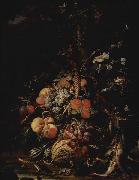 |
Abraham Mignon
|
|
(Frankfurt, June 21, 1640 - Utrecht, March 27, 1679), was a Dutch golden age painter, specialized in flower bouquets.
His father, a Frankfurt merchant, placed him under the care of the still-life painter Jacob Marrel, when he was only seven years old. Marrel specialized in flower painting, and found him to be his best pupil. He accompanied Mignon when he moved to the Netherlands about 1660 to work under Jan Davidszoon de Heem at Utrecht. In 1675 he settled there for good when he married the daughter of the painter Cornelis Willaerts (granddaughter of Adam Willaerts).
Marrel's stepdaughter Maria Sibylla Merian (1647-1717), daughter of the engraver Matthew Merian, who lived with Marrel and thus studied with Mignon, achieved distinction as a flower painter
|
|
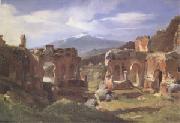 |
Achille-Etna Michallon
|
|
Paris 1796-1822
was a French painter. Michallon was the son of the sculptor Claude Michallon. He studied under Jacques-Louis David and Pierre-Henri de Valenciennes. In 1817, Michallon won the inaugural Prix de Rome for landscape painting. He travelled to Italy in 1818 and remained there for over two years. This trip had a profound influence on his work. Before he had much time to develop what he had learned however, he died at the age of 26 of pneumonia, a tragedy which cut short the life of a talented and well respected artist who could have gone on to win lasting fame. Though it is often disputed, it is thought that at one time, Corot was his pupil. |
|
|
|
|
|
|
|
|
|
|
|
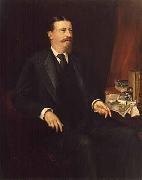 |
Adolfo Muller-Ury
|
|
(March 29, 1862 - July 6, 1947) was a Swiss-born American portrait painter and impressionistic painter of roses and still life.
He was born Felice Adolfo Meller on March 29, 1862 at Airolo, in the Ticino in Switzerland, into a prominent patrician family whose lineage descended from Alfred the Great, Charlemagne and Doge Pietro Orseolo of Venice, through the von Rechburg family (a lady from which family married a Meller) and by the 18th and 19th centuries included mercenaries, lawyers, hoteliers and businessmen. His father was lawyer Carl Alois Meller (1825 - 1887), Gerichtspräsident (Presiding Judge) of the Cantonal Courts, and his mother Genovefa Lombardi (1836 - 1920), daughter of Felice Lombardi who was Director of the Hospice on the St Gotthard Pass, which he took over from the Capuchin monks who had run this for centuries. Adolfo was their sixth of nineteen children, most of whom survived infancy. The family spoke Airolese mainly, a local dialect of Ticinese Italian, as well as Swiss-German. His family were Roman Catholic.
|
|
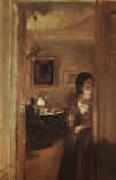 |
Adolph von Menzel
|
|
1815-1905
German
Adolph von Menzel Gallery
His father was the headmaster of a school for girls, and intended to educate his son as a professor; but he would not thwart his taste for art. Left an orphan in 1832, Menzel had to maintain his family. In 1833 Sachse of Berlin published his first work, an album of pen-and-ink drawings reproduced on stone, to illustrate Goethe's little poem, Kunstlers Erdenwallen. He executed lithographs in the same manner to illustrate Denkw??rdigkeiten aus der brandenburgisch-preussischen Geschichte; The Five Senses and The Prayer, as well as diplomas for various corporations and societies.
From 1839 to 1842 he produced 400 drawings, largely introducing to Germany the technique of wood engraving, to illustrate the Geschichte Friedrichs des Grossen (History of Frederick the Great) by Franz Kugler. He subsequently brought out Friedrichs der Grossen Armee in ihrer Uniformirung (The Uniforms of the Army under Frederick the Great), Soldaten Friedrichs der Grossen (The Soldiers of Frederick the Great); and finally, by order of the king Frederick William IV, he illustrated the works of Frederick the Great, Illustrationen zu den Werken Friedricks des Grossen (1843-1849).
By these works Menzel established his claim to be considered one of the first, if not actually the first, of the illustrators of his day in his own line.
Pencil drawing by Menzel, 1891.Meanwhile Menzel had set himself to study unaided the art of painting, and he soon produced a great number and variety of pictures, always showing keen observation and honest workmanship in subjects dealing with the life and achievements of Frederick the Great, and scenes of everyday life, such as In the Tuileries, The Ball Supper, and At Confession. Among the most important of these works are The Forge (1875) and The Market-place at Verona. Invited to paint The Coronation of William I at Koenigsberg, he produced an exact representation of the ceremony without regard to the traditions of official painting.
In Germany he received many honors, and was the first painter to be given the Order of the Black Eagle in 1898 which included a title of nobility, becoming von Menzel. |
|
|
|
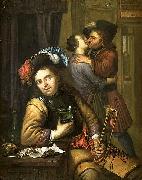 |
Albert Joseph Moore Prints
|
|
English Classicist Painter, 1841-1893
Albert Joseph Moore (4 September 1841 ?C 25 September 1893) was an English painter, known for his depictions of langorous female figures set against the luxury and decadence of the classical world.
SilverHe was born in York in 1841, the youngest of the fourteen children of the artist William Moore of York who in the first half of the 19th century enjoyed a considerable reputation in the North of England as a painter of portraits and landscape.
In his childhood Albert Moore showed an extraordinary love of art, and as he was encouraged in his tastes by his father and brothers, two of whom afterwards became famous as artists ?? John Collingham Moore and Henry Moore, and he was able to begin the active exercise of his profession at an unusually early age.
His first exhibited works were two drawings which he sent to the Royal Academy in 1857. A year later he became a student in the Royal Academy schools; but after working in them for a few months only he decided that he would be more profitably occupied in independent practice. During the period that extended from 1858 to 1870, though he produced and exhibited many pictures and drawings, he gave up much of his time to decorative work of various kinds, and painted, in 1863, a series of wall decorations at Coombe Abbey, the seat of the Earl of Craven; in 1865 and 1866 some elaborate compositions: The Last Supper and The Feeding of the Five Thousand on the chancel walls of the church of St. Alban's, Rochdale; and in 1868 A Greek Play, an important panel in tempera for the proscenium of the Queen's Theatre in Long Acre.
His first large canvas, Elijah's Sacrifice, was completed during a stay of some five months in Rome at the beginning of 1863, and appeared at the Academy in 1865. A still larger picture, The Shunamite relating the Glories of King Solomon to her Maidens, was exhibited in 1866, and with it two smaller works, Apricots and Pomegranates. In these Albert Moore asserted plainly the particular technical conviction that for the rest of his life governed the whole of his practice, and with them he first took his place definitely among the most original of British painters. |
|
 |
Albert Joseph Moore,ARWS
|
|
181-1893
He showed precocious artistic talent as a child and entered the Royal Academy Schools in London in 1858. His early work shows a Pre-Raphaelite influence common to his generation. The watercolour Study of an Ash Trunk (1857; Oxford, Ashmolean) is very Ruskinian in its precise handling of naturalistic detail. Moore made two visits abroad: in 1859 to France with the architect William Eden Nesfield and in the winter of 1862-3 to Rome with his brother John Collingham Moore. Elijah's Sacrifice (1863; exh. RA 1865; Bury St Edmunds, A.G.), one of Moore's earliest large-scale oil paintings, was executed while he was in Rome. Its biblical subject and sombre tone are typical of his output in the early 1860s and relate to the work of Ford Madox Brown and Edward Armitage. |
|
 |
ALBERTINELLI Mariotto
|
|
Italian Early Renaissance Painter, 1474-1515
Already as a 12-year old boy, he became a pupil of Cosimo Rosselli, and a fellow-pupil with Fra Bartolomeo with whom he formed such an intimate brotherly rapport that in 1494 the two started their own studio in Florence. Vasari's opinion was that Mariotto was not so well grounded in drawing as Bartolomeo, and he tells that, to improve his hand he had taken to drawing the antiquities in the Medici garden, where he was encouraged by Madonna Alfonsina, the mother of Duke Lorenzo II de' Medici. When the Medici were temporarily banished in 1494, he returned to his friend, whose manner he copied so assiduously, according to Vasari, that his works were taken for Baccio's. When, in the wake of Savonarola's morality campaign, Baccio joined the Dominican order as Fra Bartolomeo in 1500 and gave up painting, Albertinelli, beside himself with the loss, would have joined him; but, spurred by his success in completing an unfinished Last Judgment of Bartolomeo's, he resolved to carry on alone. Among his many students were Jacopo da Pontormo, Innocenzo di Pietro Francucci da Imola and Giuliano Bugiardini.
Albertinelli's paintings bear the imprint of Perugino's sense of volumes in space and perspective, Fra Bartolomeo's coloring, the landscape portrayal of Flemish masters like Memling, and Leonardo's Sfumato technique. His chief paintings are in Florence, notably his masterpiece, the Visitation (1503) at the Uffizi. |
|
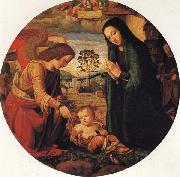 |
ALBERTINELLI Mariotto
|
|
Italian Early Renaissance Painter, 1474-1515
Italian painter. Albertinelli's contribution to the Florentine High Renaissance was inspired by the work of FRA BARTOLOMMEO, and the two artists worked together in a partnership, their paintings appearing to be the product of a single hand. Albertinelli, however, always retained artistic independence, as is revealed in certain paintings that are eccentrically archaic and in others that show a preference for conventions more typical of the early Renaissance. |
|
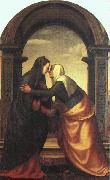 |
Albertinelli, Mariotto
|
|
Italian Early Renaissance Painter, 1474-1515] Studied under Cosimo Rosselli. Albertinelli's students included Pontormo . Italian painter. Albertinelli's contribution to the Florentine High Renaissance was inspired by the work of FRA BARTOLOMMEO, and the two artists worked together in a partnership, their paintings appearing to be the product of a single hand. Albertinelli, however, always retained artistic independence, as is revealed in certain paintings that are eccentrically archaic and in others that show a preference for conventions more typical of the early Renaissance. |
|
|
|
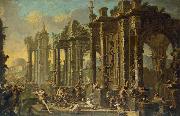 |
Alessandro Magnasco
|
|
(February 4, 1667 - March 12, 1749), also known as il Lissandrino, was an Italian Rococo painter from Northern Italy. He is best known for stylized, fantastic, often phantasmagoric genre or landscape scenes.
|
|
|
|
 |
Alexander Mann
|
|
Alexander Mann (January 22, 1853 - January 26, 1908) was a Scottish landscape and genre painter. He was a member of New English Art Club and Royal Institute of Oil Painters.
Alexander Mann was born in Glasgow, Scotland on January 22, 1853. He died in London on January 26, 1908.
The second son of James Mann, merchant and collector, he took drawing lessons from the age of ten with Robert Greenlees (1820-94) and then attended evening classes at the Glasgow School of Art, where Greenlees was headmaster.
In 1877 he went to Paris and enrolled at the Academie Julian, and then studied under Mihely Munk? - sy and from 1881 to 1885 under Carolus-Duran. From 1883-93 Mann exhibited in London at the Royal Academy, Royal Institute of Oil Painters, Fine Art Society, New Gallery, Ridley Art Club, New English Art Club and Society of British Artists, a society that appointed James McNeill Whistler its President in 1886. At the same year he was invited to become the first Scottish member of the New English Art Club and was joined by several of his friends, notably John Lavery, Thomas Millie Dow of the Glasgow Boys and Norman Garstin.
Influenced by the Hague school and by Jules Bastien-Lepage, his picture A Bead Stringer, Venice gained an honorable mention at the Salon in 1885. After a public controversy over this painting when it was exhibited at the Royal Glasgow Institute, Mann settled in England, at West Hagbourne, Berkshire, and later in the neighboring village of Blewbury, where he painted a series of views of the Downs and portraits of country people. Mann traveled extensively in Britain, paying several visits to the coast in Angus and Fife, and to Walberswick, Suffolk. |
|
|
|
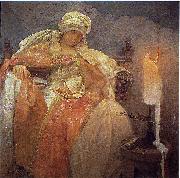 |
Alfons Mucha
|
|
known in English as Alphonse Mucha, was a Czech Art Nouveau painter and decorative artist, known best for his distinct style. He produced many paintings, illustrations, advertisements, postcards, and designs.
Alphonse Maria Mucha was born in the town of Ivančice, Moravia (the present Czech Republic). Although his singing abilities allowed him to continue his education through high school in the Moravian capital of Brno, drawing had been his main hobby since childhood. He worked at decorative painting jobs in Moravia, mostly painting theatrical scenery. During 1879, he relocated to Vienna to work for a major Viennese theatrical design company, while informally augmenting his artistic education. When a fire destroyed his employer's business during 1881 he returned to Moravia, to do freelance decorative and portrait painting. Count Karl Khuen of Mikulov hired Mucha to decorate Hrušovany Emmahof Castle with murals, and was impressed enough that he agreed to sponsor Mucha's formal training at the Munich Academy of Fine Arts.
|
|
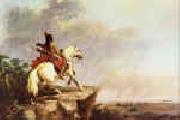 |
Alfred Jacob Miller
|
|
American Painter, 1810-1874
1810?C74, American artist, b. Baltimore, studied under Thomas Sully and in Europe. In 1837 he joined an expedition to the American West and was probably the first artist to depict the Rocky Mts. On that trip he produced his most important works, chiefly studies of Native American and frontier life, valuable for their documentary detail. These sketches and watercolors were entirely forgotten for nearly a century until they were rediscovered in a storeroom of the Peale Museum, Baltimore. |
|
|
|
 |
Alphonse Mucha
|
|
1860-1939
Czech
Alfons Maria Mucha was born in the town of Ivančice, Moravia (today's region of Czech Republic). His singing abilities allowed him to continue his education through high school in the Moravian capital of Brno, even though drawing had been his first love since childhood. He worked at decorative painting jobs in Moravia, mostly painting theatrical scenery, then in 1879 moved to Vienna to work for a leading Viennese theatrical design company, while informally furthering his artistic education. When a fire destroyed his employer's business in 1881 he returned to Moravia, doing freelance decorative and portrait painting. Count Karl Khuen of Mikulov hired Mucha to decorate Hrusovany Emmahof Castle with murals, and was impressed enough that he agreed to sponsor Mucha's formal training at the Munich Academy of Fine Arts.
Poster of Maude Adams as Joan of Arc, 1909Mucha moved to Paris in 1887, and continued his studies at Academie Julian and Academie Colarossi while also producing magazine and advertising illustrations. Around Christmas 1894, Mucha happened to drop into a print shop where there was a sudden and unexpected demand for a new poster to advertise a play starring Sarah Bernhardt, the most famous actress in Paris, at the Theatre de la Renaissance. Mucha volunteered to produce a lithographed poster within two weeks, and on 1 January 1895, the advertisement for Gismonda appeared on the streets of the city. It was an overnight sensation and announced the new artistic style and its creator to the citizens of Paris. Bernhardt was so satisfied with the success of that first poster that she entered into a 6 years contract with Mucha.
Mucha produced a flurry of paintings, posters, advertisements, and book illustrations, as well as designs for jewellery, carpets, wallpaper, and theatre sets in what was initially called the Mucha Style but became known as Art Nouveau. Mucha's works frequently featured beautiful healthy young women in flowing vaguely Neoclassical looking robes, often surrounded by lush flowers which sometimes formed haloes behind the women's heads. In contrast with contemporary poster makers he used paler pastel colors. The 1900 Universal Exhibition in Paris diffused the "Mucha style" internationally. He decorated the Bosnia and Herzegovina Pavilion and collaborated in the Austrian one. His Art Nouveau style was often imitated. However, this was a style that Mucha attempted to distance himself from throughout his life; he insisted always that, rather than adhering to any fashionable stylistic form, his paintings came purely from within and Czech art. He declared that art existed only to communicate a spiritual message, and nothing more; hence his frustration at the fame he gained through commercial art, when he wanted always to concentrate on more lofty projects that would ennoble art and his birthplace.
|
|
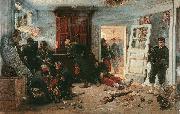 |
Alphonse-Marie-Adolphe de Neuville
|
|
(31 May 1835 - 18 May 1885) was a French Academic painter who studied under Eugene Delacroix. His dramatic and intensely patriotic subjects illustrated episodes from the Franco-Prussian War, the Crimean War, the Zulu War and portraits of soldiers. Some of his works have been collected by the Hermitage Museum in St. Petersburg and by the Metropolitan Museum in New York.
The Last Cartridges, 1873
The Defence of Rorke's Drift, oil on canvas painting by Alphonse-Marie-Adolphe de Neuville, 1880, Art Gallery of New South Wales. This incident occurred on 22 January 1879, in the Anglo-Zulu War.
La bataille de VillersexelHe was born to wealthy parents at Saint-Omer, Pas-de-Calais. From school he went to college, where he took his degree of bachelier -lettres. In spite of the opposition of his family he entered the naval school at Lorient, and it was there, in 1856, that his artistic instincts first declared themselves.
After being discouraged by several painters of repute, he was admitted to work in François-Edouard Picot's studio. He did not remain there long, and he was painting by himself when he produced his first picture, The Fifth Battalion of Chasseurs at the Gervais Battery (Malakoff). In 1860 Neuville painted an Episode of the taking of Naples by Garibaldi for the Artists' Club in the rue de Provence, and sent to the Paris Salon in 1861 The Guard Chasseurs in the Trenches of the Mamelon Vert.
He participated in illustrating the Hetzel editions of Twenty Thousand Leagues Under the Sea. He also illustrated Le Tour du monde and Guizot's History of France. At the same time he painted a number of remarkable pictures: The Attack in the Streets of Magenta by Zouaves and the Light Horse (1864), A Zouave Sentinel (1865), The Battle of San Lorenzo (1867), and Dismounted Cavalry crossing the Tchernaia (1869). In these he showed peculiar insight into military life, but his full power was not reached until after the Franco-Prussian War. He then aimed at depicting in his works the episodes of that war, and began by representing the Bivouac before Le Bourget (1872). His fame spread rapidly, and was increased by The Last Cartridges (1873), memorializing an episode involving the Blue Division of the French marines, in which it is easy to discern the vast difference between the conventional treatment of military subjects, as practised by Horace Vernet, and that of a man who had lived the life that he painted.
In 1874 the Fight on a Railroad was not less successful, and was followed by the Attack on a House at Villersexel (1875) and the Railway Bridge at Styring (1877). In 1878 the painter exhibited (not at the Great Exhibition) Le Bourget, the Surprise at Daybreak, The Intercepted Despatch-bearer, and a considerable number of drawings. He also exhibited in London some episodes of the Zulu War. Fifty thousand people paid to see his impression of The Defence of Rorke's Drift (1880), which the infant Art Gallery of New South Wales in Sydney paid a large sum to acquire.
In 1881 he was made an officer of the Legion d'honneur for The Cemetery of Saint-Privat and The Despatch-bearer and the "Huns in the Battle of Chalon." During these years Neuville was at work with Édouard Detaille on an important though less artistic work, The Panorama of Rezonville. Neuville died in Paris on May 18, 1885. At the sale of his works the state purchased for the Palais du Luxembourg the Bourget and the Attack on a Barricaded House, with a water-color The Parley, and a drawing of a Turco in Fighting Trim.
|
|
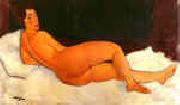 |
Amedeo Modigliani
|
|
Italian Expressionist Painter and Sculptor, 1884-1920
Amedeo Clemente Modigliani (July 12, 1884 ?C January 24, 1920) was an Italian artist of Jewish heritage, practicing both painting and sculpture, who pursued his career for the most part in France. Modigliani was born in Livorno (historically referred to in English as Leghorn), in northwestern Italy and began his artistic studies in Italy before moving to Paris in 1906. Influenced by the artists in his circle of friends and associates, by a range of genres and art movements, and by primitive art, Modigliani's œuvre was nonetheless unique and idiosyncratic. He died in Paris of tubercular meningitis, exacerbated by poverty, overworking, and an excessive use of alcohol and narcotics, at the age of 35. |
|
|
|
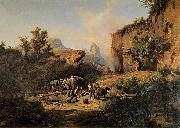 |
Andras Marko
|
|
painted Landscape with Charcoal Burners in 1861 |
|
 |
ANDREA DA MURANO
|
|
Italian painter, Venetian school (known 1462-1502)
Italian painter. He is first recorded working as a gilder at S Zaccaria, Venice, in 1463-5. He was one of a number of artists from the island of Murano. Among these he is closest to Bartolomeo Vivarini, whose pupil he may have been. The two collaborated in 1468 on a narrative canvas (destr.) for the Scuola di S Marco, Venice, which probably depicted scenes from the Life of Abraham. The rather harsh sculptural quality of his forms owes much to the influence of Mantegna and Donatello in Padua, and his work has often been associated (and sometimes confused) with that of Andrea del Castagno. He did not, however, ignore the more recent developments of Giovanni Bellini. His triptych depicting SS Vincent Ferrer, Roch, Sebastian and Peter Martyr, with a lunette of the Madonna of Mercy and Four Saints (Venice, Accad.), probably painted in the late 1470s, shows a real concern with light and colour. By the mid-1480s Andrea had settled in Castelfranco on the mainland, chiefly painting altarpieces in the (by then well established) Venetian sacra conversazione form. The altarpiece (1484-1502) in the parish church at Trebaseleghe, nr Padua, is a variation on the form, with Christ embracing the plague saints Sebastian and Roch above and other saints and musicians below, all showing the high degree of expression characteristic of his works. It is one of his finest paintings and also perhaps the most expensive Venetian altarpiece of its day. The altarpiece depicting the Virgin Enthroned with SS Peter, Nicholas of Bari, John the Baptist and Paul (1502; Mussolente, Santuario della Madonna dell' Acqua) is typical of Andrea's work and shows both the strengths and limitations of his art: firm draughtsmanship and expressive qualities combined with a rather conservative composition and somewhat ungainly figures. |
|
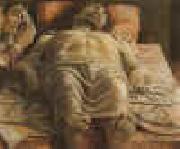 |
Andrea Mantegna
|
|
Italian
1431-1506
Andrea Mantegna Locations
Mantegna was born in Isola di Carturo, close to Padua in the Republic of Venice, second son of a carpenter, Biagio. At the age of eleven he became the apprentice of Francesco Squarcione, Paduan painter. Squarcione, whose original vocation was tailoring, appears to have had a remarkable enthusiasm for ancient art, and a faculty for acting. Like his famous compatriot Petrarca, Squarcione was something of a fanatic for ancient Rome: he travelled in Italy, and perhaps Greece, amassing antique statues, reliefs, vases, etc., forming a collection of such works, then making drawings from them himself, and throwing open his stores for others to study. All the while, he continued undertaking works on commission for which his pupils no less than himself were made available.
San Zeno Altarpiece, (left panel), 1457-60; San Zeno, VeronaAs many as 137 painters and pictorial students passed through Squarcine's school, which had been established towards 1440 and which became famous all over Italy. Padua was attractive for artists coming not only from Veneto but also from Tuscany, such as Paolo Uccello, Filippo Lippi and Donatello. Mantegna's early career was shaped indeed by impressions of Florentine works. At the time, Mantegna was said to be a favorite pupil; Squarcione taught him the Latin language, and instructed him to study fragments of Roman sculpture. The master also preferred forced perspective, the lingering results of which may account for some Mantegna's later innovations. However, at the age of seventeen, Mantegna separated himself from Squarcione. He later claimed that Squarcione had profited from his work without paying the rights.
His first work, now lost, was an altarpiece for the church of Santa Sofia in 1448. The same year Mantegna was called, together with Nicol?? Pizolo, to work with a large group of painters entrusted with the decoration of the Ovetari Chapel in the apse of the church of Eremitani. It is probable, however, that before this time some of the pupils of Squarcione, including Mantegna, had already begun the series of frescoes in the chapel of S. Cristoforo, in the church of Sant'Agostino degli Eremitani, today considered his masterpiece. After a series of coincidences, Mantegna finished most of the work alone, though Ansuino, who collaborated with Mantegna in the Ovetari Chapel, brought his style in the Forl?? school of painting. The now censorious Squarcione carped about the earlier works of this series, illustrating the life of St James; he said the figures were like men of stone, and had better have been colored stone-color at once.
This series was almost entirely lost in the 1944 Allied bombings of Padua. The most dramatic work of the fresco cycle was the work set in the worm's-eye view perspective, St. James Led to His Execution. (For an example of Mantegna's use of a lowered view point, see the image at right of Saints Peter and Paul; though much less dramatic in its perspective that the St. James picture, the San Zeno altarpiece was done shortly after the St. James cycle was finished, and uses many of the same techniques, including the classicizing architectural structure.)
San Luca Altarpiece, 1453; Tempera on panel; Pinacoteca di Brera, MilanThe sketch of the St. Stephen fresco survived and is the earliest known preliminary sketch which still exists to compare to the corresponding fresco. Despite the authentic look of the monument, it is not a copy of any known Roman structure. Mantegna also adopted the wet drapery patterns of the Romans, who derived the form from the Greek invention, for the clothing of his figures, although the tense figures and interactions are derived from Donatello. The drawing shows proof that nude figures were used in the conception of works during the Early Renaissance. In the preliminary sketch, the perspective is less developed and closer to a more average viewpoint however.
Among the other early Mantegna frescoes are the two saints over the entrance porch of the church of Sant'Antonio in Padua, 1452, and an altarpiece of St. Luke and other saints (at left) for the church of S. Giustina, now in the Brera Gallery in Milan (1453). As the young artist progressed in his work, he came under the influence of Jacopo Bellini, father of the celebrated painters Giovanni and Gentile, and of a daughter Nicolosia. In 1453 Jacopo consented to a marriage between Nicolosia to Mantegna in marriage.
|
|
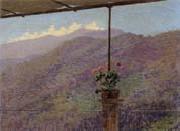 |
Angelo Morbelli
|
|
Alessandria 1853-1918 Milan,Italian painter. He received his first lessons in drawing in Alessandria, and in 1867 he travelled on a local study grant to Milan, where he was based for the rest of his life. He enrolled at the Accademia di Brera and from 1867 to 1876 studied drawing and painting there under Raffaele Casnedi and Giuseppe Bertini, whose influence is seen in both the subject-matter and technique of his early works. These include perspectival views, anecdotal genre scenes and history paintings. In the Dying Goethe (1880; Alessandria, Pin. Civ.) the theatrical setting, enriched by a sophisticated execution and a well-modulated use of colour, derives from the teaching of Casnedi and Bertini, while the historic-romantic quality of this painting also recalls the style of Francesco Hayez. |
|
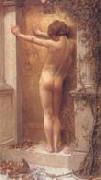 |
Anna Lea Merritt
|
|
American Pre-Raphaelite Painter, 1844-1930
English painter, muralist and printmaker of American birth. She is best known for her Victorian portraits, allegorical and religious paintings, landscapes and floral scenes and was successful in spite of the difficulties that she encountered as a professional woman artist working in Victorian England. After brief artistic tours to Florence, Dresden and Paris, where she studied in L?on Cogniet's atelier, she began intensive instruction in 1870 from Henry Merritt (1822-77), an Englishman who restored works of art from important collections and wrote on art, exhibitions and conservation. Anna Lea and Henry Merritt were married in July 1877; three months later he died. Love Locked out (1889; London, Tate), depicting love at the door of a tomb, was painted as a memorial to her husband. |
|
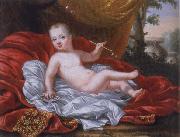 |
Anna Maria Ehrenstrahl
|
|
1666-1729,as married Wattrang, (1666-1729), was Swedish painter, the first female painter in her country. She was a baroque-artist and painted allegorys, portraits and group portraits in the style of the Baroque. Born as child of the court painter David Klocker Ehrenstrahl and Maria Momma, she was instructed as a student by her father to copy and finish his works and to paint details and other such smaller things to complete the paintings in his studio. She is confirmed as her fathers assistant from ca 1680. Her learning as an artist was therefore not complete, as he never intended her to become an independent artist, just as a form of artistic secretary in his studio, but she was in fact to create paintings herself eventually. In 1688 she married Johan Wattrang, vice president in Svea Hovratt, and painted six portraits of this courts former presidents, which she gave the court signed with her own name (1717). Her way of painting was in the same barocque style as her father; she painted allergorys and portraits of both single people and groups, bot real people and mytholocigal figures in the style of the time. Among them was portraits of king Charles XI of Sweden, Prince Ulrik (in 1685), an allegory over the four seasons (1687) and an allegory of Cupid and Psyche. She painted the four king's under her lifetime, the Princes Gustaf and Fredrik, Ulrika Eleonora of Denmark and Aurora Konigsmarck. |
|
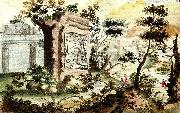 |
anna maria thelott
|
|
Anna Maria Thelott, född 1683, död 1710, var en svensk konstnär. Thelott var en av de första självförsörjande och professionella kvinnliga konstnärerna i Skandinavien.
Anna Maria Thelott var dotter till instrumentmakaren och konstnären Philip Jacob Thelott d.ä., som ursprungligen kom från Schweiz, och syster till konstnären Philip Jacob Thelott d.y. Hon arbetade redan som barn sin med far och sina bröder i arbetet med att illustrera Olof Rudbeck d.ä.:s "Campus Elysii" och "Atlantica", och bidrog snart till hushållets försörjning genom att ensam utföra olika konstnärliga arbeten mot betalning, vilket gjorde henne till landets troligen första kvinnliga yrkeskonstnär.
Familjen bodde ursprungligen i Uppsala, men flyttade år 1702 till Stockholm efter den stora stadsbranden då en stor del av Uppsala brann ned.
Thelott var en mångsidig konstnär som var kunnig på en rad områden; hon utförde träsnitt och kopparstick förutom teckning och illustrationer med allegoriska och religiösa motiv, miniatyrer och bilder av djur och landskapsmålningar. Hon utförde elva träsnitt av tyska städer med tillhörande informativ text på uppdrag av Posttidningen år 1706 och anlitades för att illustrera Peringskiölds arbeten.
År 1710 dog Anna Maria Thelott i Stockholm som en av många offer för den sista pesten i Sverige. På Uppsala universitetsbibliotek finns en skissbok av henne utförd 1704-1709. |
|
|
|
 |
Anthonie van Montfoort
|
|
(Montfoort, 1533 or 1534 - Utrecht, 1583) was a Dutch painter
His father was a mayor of Montfoort. He went to learn under Hendrick Sweersz. in Delft and Frans Floris in Antwerp. In 1552 he returned to Montfoort, where he married the daughter of the then mayor.
Blocklandt then settled in Delft, where he produced paintings for the Oude Kerk and the Nieuwe Kerk, later lost to the beeldenstorm. Also he painted a work for the Janskerk (Gouda) called De onthoofding van Saint-Jacob, now in the museum there.
In 1572, Blocklandt made a trip to Italy, after which he settled for good in Utrecht, joining a guild there in 1577. In 1579, he painted his best known work, the triptych The Assumption of Mary that is now in the Basilica of St. Martin in Bingen am Rhein.
According to Carel van Mander, Blocklandt painted biblical scenes, mythological subjects and portraits. He is early-Mannerist in style and he and Joos de Beer (another pupil of Floris) were responsible for the Mannerist style begun by Utrecht artists around 1590. Van Mander wrote that De Beer had many paintings by Blocklandt in his workshop that his pupil Abraham Bloemaert later copied. Few works can definitely be attributed to him. One of these is "Joseph interpreting Pharaoh's dream", now in the Centraal Museum in Utrecht.
He was also the teacher of the Delft portrait painter Michiel Jansz van Mierevelt.
|
|
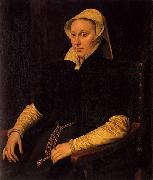 |
Anthonis Mor
|
|
(c. 1517 - 1577) was a Netherlandish portrait painter, much in demand by the courts of Europe. He has also been referred to as Antoon, Anthonius, Anthonis, or Mor van Dashorst, Antonio Moro, Anthony More, etc., but signed most of his portraits as, Anthonis Mor.
Mor was born in Utrecht, Netherlands by some estimation between 1516 and 1520. What is known of his early life is that his artistic education commenced under Jan van Scorel. His earliest work is probably a portrait at Stockholm, dated 1538.
A group of Knights of St. John, at Utrecht, supposed to have been painted about 1541; a picture of two pilgrims at the Gemäldegalerie, Berlin, dated 1544; together with the portrait of an unknown woman, in the Lille gallery, were probably among his earliest works although their authenticity has not been proved.
In 1547, he was received as a member of the Venerable Guild of St. Luke at Antwerp, and shortly afterwards (about 1548) he attracted the attention of Cardinal Granvelle, Bishop of Arras, who became his steady patron. Of the portraits executed during the early period of his career as Granvelle's protege, two are especially notable: one of the bishop himself (in the imperial gallery in Vienna), and one of the Duke of Alba, which now belongs to the Hispanic Society of New York. Between 1549 and 1550 Prince Philip II of Spain (1527-1598) traveled around the Netherlands to present himself as the future ruler. Mor painted his portrait in Brussels in 1549. He probably visited Italy (when exactly is not known) where he copied some works by Titian, notably the Danaë. |
|
|
|
|
|
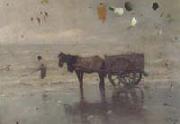 |
Anton mauve
|
|
Dutch Painter, 1838-1888
He came from a large family of clergymen in the province of North Holland. At the age of 16 he was apprenticed to the animal painter Pieter Frederik van Os (1808-92): animals (especially sheep, but also cows and horses) became Mauve's preferred theme. He then trained for a few months with Wouterus Verschuur, who gave him his love of horses, in the style, at least, of Paulus Potter and Philips Wouwerman. |
|
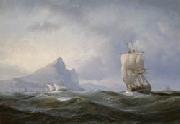 |
Anton Melbye
|
|
(1818-1875) was a Danish painter. He studied at the Royal Danish Academy of Fine Arts and was a private student of Christoffer Wilhelm Eckersberg. He achieved international success as a marine artist, travelling widely especially to Morocco and Turkey.
His paintings are realistic, often enhanced with dramatic light and weather effects as in Eddystone Lighthouse (1846) which earned him the Thorvaldsen Medal. He was also influenced by Camille Corot whom he met in Paris where he lived from 1847 to 1858.
While in Paris he met Napoleon III who ordered a large painting from him. |
|
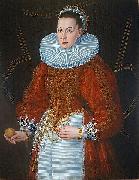 |
Anton Moller
|
|
Anton Moller (1563 - January 1611) was a German painter and draughtsman.
Moller was born in Konigsberg. He primarily painted religious themed works. He also produced a number of woodcuts. Möller died in Danzig in 1611. |
|
|
|
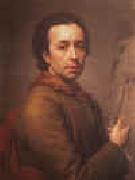 |
Anton Raphael Mengs
|
|
1728-1779
Dutch
Anton Raphael Mengs Gallery
Mengs was born in 1728 at Usti nad Labem (German: Aussig) in Bohemia on 12 March 1728; he died in Rome 29 June 1779. His father, Ismael Mengs, a Danish painter, established himself finally at Dresden, whence in 1741 he took his son to Rome.
In Rome, his fresco painting of Parnassus at Villa Albani gained him a reputation as a master painter. The appointment of Mengs in 1749 as first painter to Frederick Augustus, elector of Saxony did not prevent his spending much time in Rome, where he had married Margarita Quazzi who had sat for him as a model in 1748, and abjured the Protestant faith, and where he became in 1754 director of the Vatican school of painting, nor did this hinder him on two occasions from obeying the call of Charles III of Spain to Madrid. There Mengs produced some of his best work, and specially the ceiling of the banqueting-hall of the Royal Palace of Madrid, the subject of which was the Triumph of Trajan and the Temple of Glory. Among his pupils there was Agust??n Esteve. After the completion of this work in 1777, Mengs returned to Rome, and there he died, two years later, in poor circumstances, leaving twenty children, seven of whom were pensioned by the king of Spain. His portraits and autoportraits recall an attention to detail and insight, often lost from the grand manner paintings.
Besides numerous paintings in the Madrid gallery, the Ascension and St Joseph at Dresden, Perseus and Andromeda at Saint Petersburg, and the ceiling of the Villa Albani must be mentioned among his chief works. In 1911, Henry George Percy, 7th Duke of Northumberland, possessed a Holy Family, and the colleges of All Souls and Magdalen, at Oxford, possessed altar-pieces by Mengs's hand.
In his writings, in Spanish, Italian and German, Mengs has put forth his eclectic theory of art, which treats of perfection as attainable by a well-schemed combination of diverse excellences Greek design, with the expression of Raphael, the chiaroscuro of Correggio, and the colour of Titian. He would have fancied himself the first neoclassicist, while in fact he may be the last flicker of Baroque art. Or in the words of Wittkower, In the last analysis, he is as much an end as a beginning.
His intimacy with Johann Joachim Winckelmann, who constantly wrote at his dictation, has enhanced his historical importance, for he formed no scholars, and the critic must now concur in Goethe's judgment of Mengs in Winckelmann und sein Jahrhundert; he must deplore that so much learning should have been allied to a total want of initiative and poverty of invention, and embodied with a strained and artificial mannerism.
Mengs was famous for his rivalry with the contemporary Italian painter Pompeo Batoni. |
|
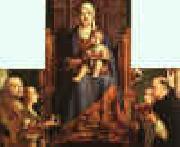 |
Antonello da Messina
|
|
1430-1479
Italian
Antonello da Messina Galleries
Antonello was born at Messina around 1429-1431, to Giovanni de Antonio Mazonus and Garita (Margherita). He was probably apprenticed in his native city and in Palermo.
Around the year 1450, according to a 1524 letter of the Neapolitan humanist Pietro Summonte,[1] he was a pupil of the painter Niccol?? Colantonio at Naples, then one of the most active centres of Renaissance arts.
Around 1455 he painted the so-called Sibiu Crucifixion, which was inspired by the Flemish Calvaries and is housed in the Muzeul de Art?? in Bucharest. Of the same years is the Crucifixion in the Royal Museum of Antwerp: his early works shows a marked Flemish influence, which it is now understood he derived from his master Colantonio and from works by Rogier van der Weyden and Jan van Eyck that belonged to Colantonio's patron, Alfonso V of Aragon; his biographer Vasari remarked that Antonello saw at Naples an oil painting by Jan Van Eyck (the "Lomellini Tryptych") belonging to King Alphonso of Aragon; Vasari's further narrative, that being struck by the new method, set out for The Netherlands to acquire a knowledge of the process from Van Eyck's disciples is discredited today. Another theory, supported only by vague documentary evidence, suggests that in 1456 Antonello visited Milan, where he might have met Van Eyck's most accomplished follower, Petrus Christus. Since Antonello was one of the first Italians to master Eyckian oil painting, and Christus was the first Netherlandish painter to learn Italian linear perspective, their meeting is a tempting answer to both questions. But in fact, neither artist is known for certain to have been in Milan at the time.
The following year, Antonello received his first commission as an independent artist, a banner for the Confraternit?? di San Michele dei Gerbini in Reggio Calabria. At this date, he was already married, and his son Jacobello had been born.
In 1460, his father is mentioned leasing a brigantine to bring back Antonello and his family from Amaltea, a town in Calabria. In that year, Antonello painted the so-called Salting Madonna, in which standard iconography and Flemish style are backed by a greater attention in the volumetric proportions of the figures, probably coming from his knowledge of some works by Piero della Francesca. Also from around 1460 are the two small panels depicting Abraham Served by the Angels and St. Jerome Penitent now in the Museo Nazionale della Magna Grecia in Reggio Calabria. In 1461 his younger brother Giordano entered Antonello's workshop, signing a three-years' contract. Of that year is a Madonna with Child for the Messinese nobleman Giovanni Mirulla, now lost.
Between 1465-1470, Antonello finished a Portrait of a Man now at Cefal??. His portraits are noteworthy for his characteristic use of the three-quarter view, typical of the Flemish School, whereas almost all Italian painters adopted the medal profile pose. Antonello travelled to Venice around 1470, to see Giovanni Bellini's paintings.
The Palermo Annunciation.In this year he executed his first signed and dated work, the Salvator Mundi. Back at Sicily, Antonello finished the St. Gregory's Polyptych.
In 1474, he painted the Annunciation, now in Syracuse, and the St. Jerome in His Study, one of his most famous paintings. The following year he began his regular sojourn in Venice, where he remained until the fall of 1476. His works of this period begin to show a greater attention to the human figure, regarding both anatomy and expressivity, according to the influence of Piero della Francesca and Bellini.
His most famous pictures dating from this period include the Condottiero (Louvre, illustration), the San Cassiano Altarpiece and the St. Sebastian (see selected works for details). The San Cassiano Altarpiece was especially influential on Venetian painters, as it was one of the first of the large compositions in the sacra conversazione format which was perfected by Giovanni Bellini (Antonello's surviving work in Vienna is only a fragment of the much larger original).
Antonello returned briefly to Sicily in 1476, where he painted the famous Virgin Annunciate, now in the Palazzo Abatellis at Palermo.
He died at Messina in 1479: his testament dates from February of that year, and he is documented as no longer alive two months later. Some of his last works remained unfinished, but were completed by his son Jacobello. |
|
|
|
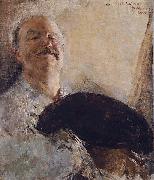 |
Antonio Mancini
|
|
(14 November 1852 - 28 December 1930) was an Italian painter.
Mancini was born in Rome and showed precocious ability as an artist. At the age of twelve, he was admitted to the Institute of Fine Arts in Naples, where he studied under Domenico Morelli (1823-1901), a painter of historical scenes who favored dramatic chiaroscuro and vigorous brushwork, and Filippo Palizzi (1818-1899), a landscape painter. Mancini developed quickly under their guidance, and in 1872, he exhibited two paintings at the Paris Salon.
Mancini worked at the forefront of Verismo movement, an indigenous Italian response to 19th-century Realist aesthetics. His usual subjects included children of the poor, juvenile circus performers, and musicians he observed in the streets of Naples. His portrait of a young acrobat in "Saltimbanco" (1877-78) exquisitely captures the fragility of the boy whose impoverished childhood is spent entertaining pedestrian crowds.
While in Paris in the 1870s, Mancini met Impressionists Edgar Degas and Édouard Manet. He became friends with John Singer Sargent, who famously pronounced him to be the greatest living painter. His mature works show a brightened palette with a striking impasto technique on canvas and a bold command of pastels on paper.
In 1881, Mancini suffered a disabling mental illness. He settled in Rome in 1883 for twenty years, then moved to Frascati where he lived until 1918. During this period of Mancini's life, he was often destitute and relied on the help of friends and art buyers to survive. After the First World War, his living situation stabilized and he achieved a new level of serenity in his work. Mancini died in Rome in 1930 and buried in the Basilica Santi Bonifacio e Alessio on the Aventine Hill.
His painting,The Poor Schoolboy, exhibited in the Salon of 1876, is in the Musee d'Orsay in Paris. Its realist subject matter and dark palette are typical of his early work. Paintings by Mancini also may be seen in major Italian museum collections, including Galleria Nazionale d'Arte Moderna e Contemporanea in Rome, and Museo Civico-Galleria d'Arte Moderna in Turin. The Philadelphia Art Museum holds fifteen oil paintings and three pastels by Mancini that were a gift of New York art dealer Vance N. Jordan. |
|
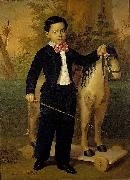 |
Antonio Maria Esquivel
|
|
Nacio en Sevilla en 1806. Comenzo los estudios de pintura en la Academia de Bellas Artes de Sevilla. Alli se familiarizo con la tecnica pictorica y el detallismo al estilo de Murillo.
En 1831, se traslado a Madrid, donde concurso en la Academia de San Fernando, siendo nombrado academico de merito. En contacto con el ambiente intectual madrileno de esos anos, participo activamente en la fundacion del Liceo Artistico y Literario en 1837, donde daria clases de Anatomia, asignatura que impartiria tambien mas tarde en la Academia de San Fernando.
En 1839, otra vez en Sevilla, sufrio una enfermedad que le dejo practicamente ciego; el artista, sumido en una profunda depresion, se intento suicidar arrojandose al rio Guadalquivir. Enterados sus companeros y amigos poetas y artistas y movilizados por el Liceo para ayudarle, sufragaron entre todos un caro tratamiento realizado por un prestigioso oftalmologo frances. Gracias a esto, en 1840 sano y recupero la vision. El artista, agradecido, pinto a sus amigos, poetas y pintores del Romanticismo, en un cuadro que se ha hecho justamente celebre. Como reconocimientos oficiales, recibo la placa del Sitio de Cadiz y la Cruz de Comendador de la Orden de Isabel la Catolica. En 1843 es nombrado Pintor de Camara y en 1847 academico de San Fernando, siendo ademas miembro fundador de la Sociedad Protectora de Bellas Artes. Como teorico de la pintura, redacto un Tratado de Anatomia Pictorica, cuyo original se guarda en el Museo del Prado. Fallecio en Madrid en 1857.
Sus hijos Carlos Maria (1830-1867) y Vicente tambien fueron pintores. |
|
 |
Antonio Maria Fabres y Costa
|
|
Spanish, 1854 - 1936
Antonio Fabres was a famous Spanish artist during the turn of the century. He was born in Barcelona Spain in 1854. It is said that he was the artist gene since his father was a draughtsman and his uncle a silversmith. He started studying at the Escuela de Bellas Artes in his native city at the age of 13. When he turned 21, he received a grant to study in Rome. There are records of his sculptures from early in his career but later on he became a painter almost exclusively. He joined Mariano Fortuny with a group that became known for their intense realism. Their popularity grew with the taste of the bourgeoisie seeking exotic images with oriental of medieval themes. He went back to Barcelona in 1886 and in 1894 he moved to Paris. The popularity he had earned during his decade in Italy helped him open a large studio where he could create complex scenes for the upper classes.
In 1902 the Academia de San Carlos decided to renovate their classical techniques with the ones of realism that were so popular in Europe at the time. Antonio Fabres was called to take the place of Santiago Rebull as head of this important institution. Although some of his students went on to become what was later known as the Post-Revolutionary Movement in Mexican art, the faculty had a hard time adapting to his distinct style and personality. In 1907, he returned to Rome. One of his last commissions in Mexico was the decorations of a hall at the Porfirio Diaz mansion where he mainly focused on art nouveau style .
Fabres was recognized most everywhere he traveled. He was acclaimed in Barcelona, London, Paris, Vienna and Lyon. At the end of his life he was dealt a very unfortunate blow when in 1926 he decided to donate a large amount of works to the Museo de Bellas Artes de Barcelona. In exchange for this generous donation he asked the Museum that a hall be built with his name, but the museum never built that hall and although he protested several times, they could never settle the argument. Antonio Fabres died in Rome in 1938.
|
|
|

